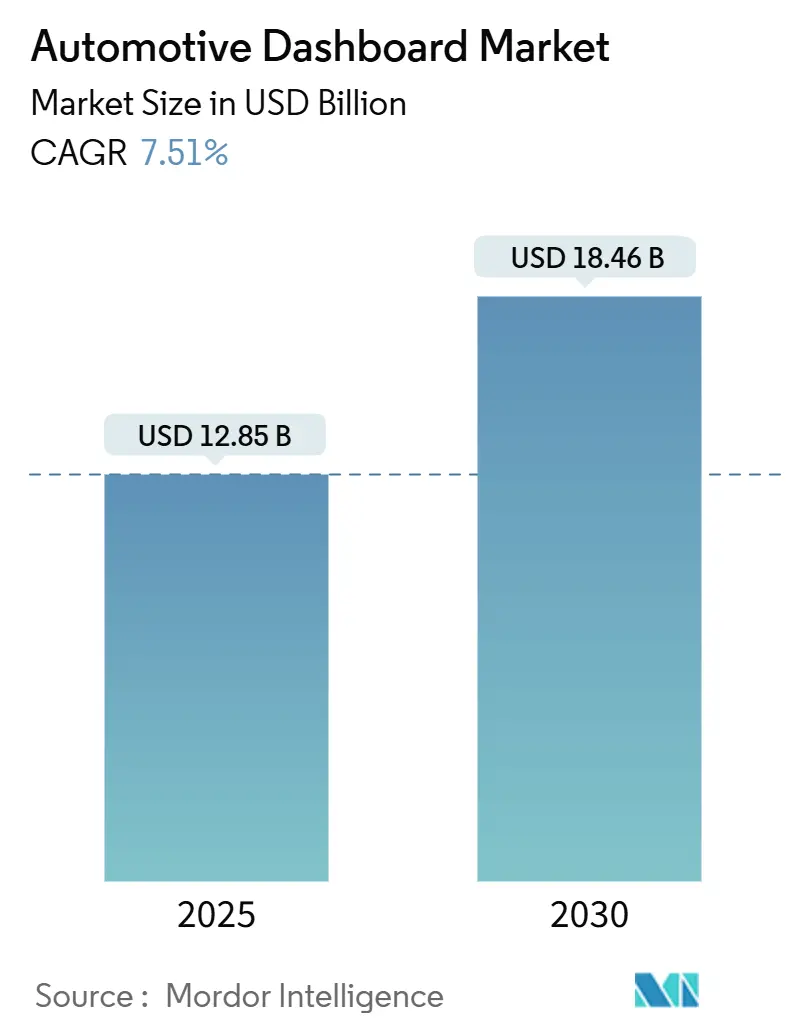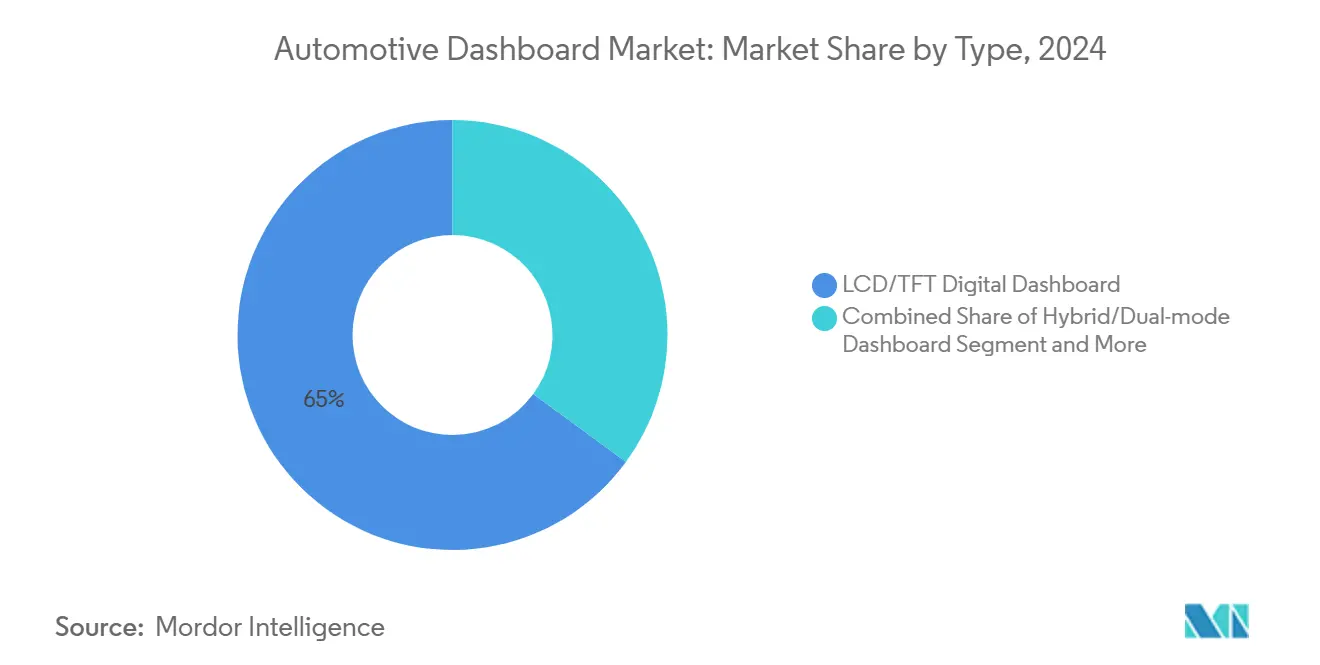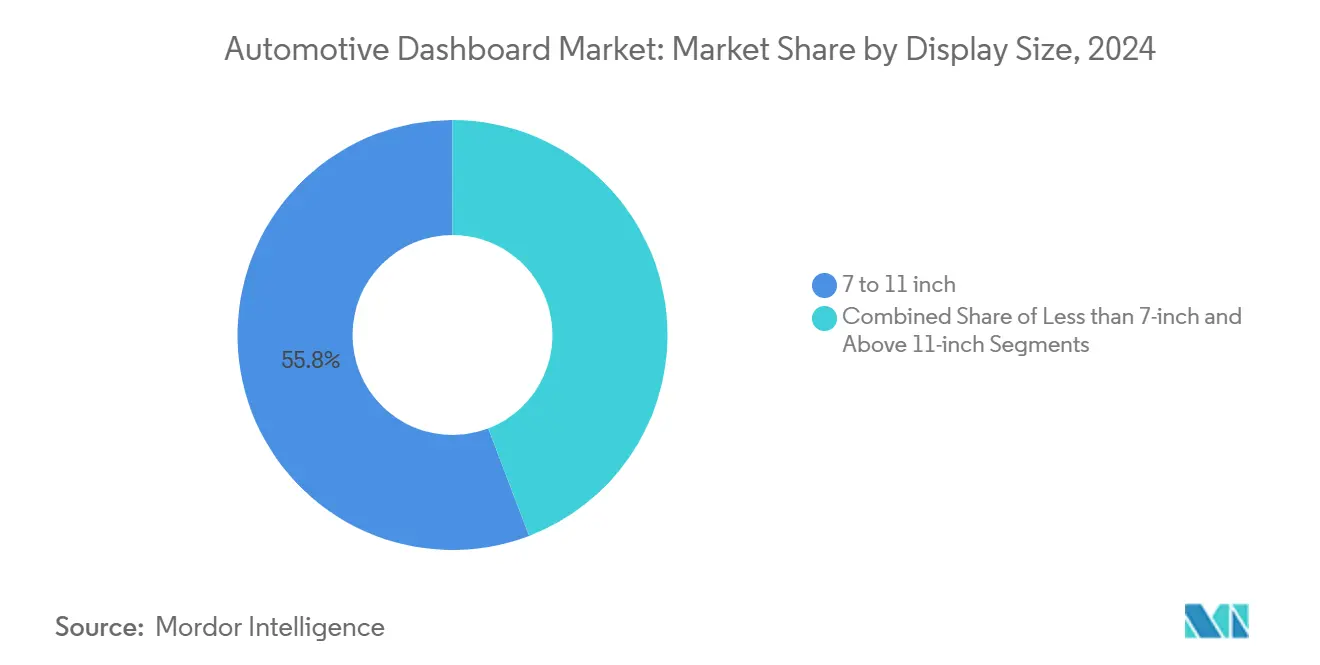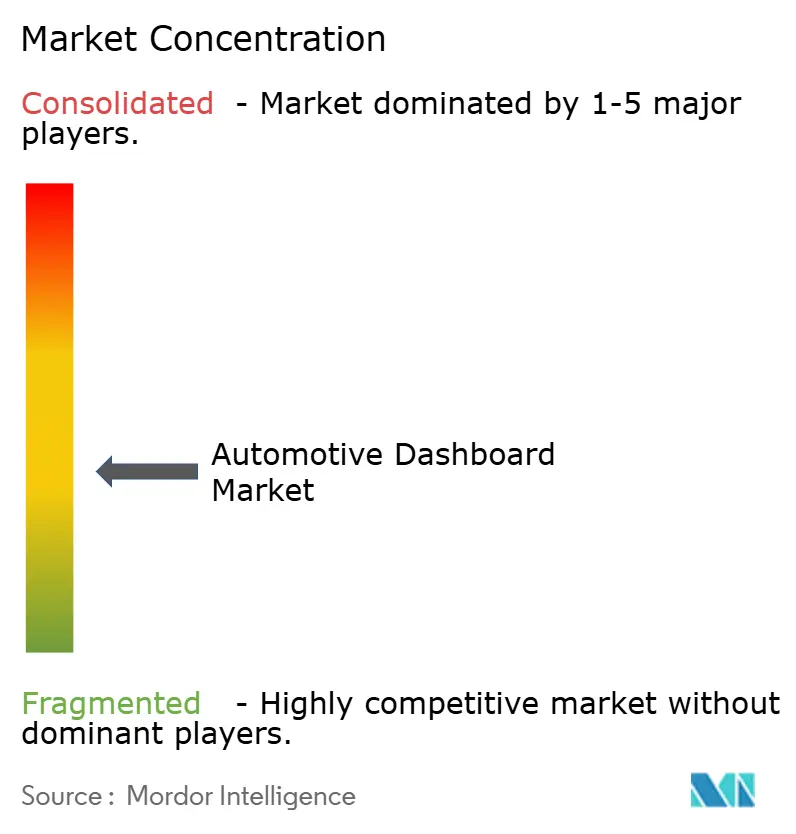Automotive Dashboard Market Size and Share

Automotive Dashboard Market Analysis by Mordor Intelligence
The automotive dashboard market size stands at USD 12.85 billion in 2025 and is forecast to reach USD 18.46 billion by 2030, reflecting a 7.51% CAGR. Strong momentum comes from the shift toward fully digital cockpits, tighter global safety requirements for display readability, and rising electric-vehicle volumes that favor software-defined interiors. Original-equipment manufacturers (OEMs) are replacing analog clusters with configurable screens built on domain-controller architectures that cut electronic control unit counts and wiring complexity. Asia-Pacific continues to anchor production scale thanks to Chinese display-panel capacity and an expansive local EV supply chain. Meanwhile, hybrid dual-mode dashboards that blend physical controls with touch displays are gaining traction as OEMs prepare for European mandates that require tactile access to critical functions.
Key Report Takeaways
- By type, LCD/TFT digital dashboards led with 64.95% revenue share in 2024; the hybrid dual-mode segment records the fastest growth at a 9.14% CAGR to 2030.
- By vehicle type, passenger cars captured 76.31% of the automotive dashboard market share in 2024 while expanding at an 8.45% CAGR through 2030.
- By sales channel, OEM installations held 88.52% of 2024 revenue; the aftermarket is projected to grow 9.66% annually to 2030.
- By component, display panels accounted for 46.33% share of the automotive dashboard market size in 2024; control electronics and system-on-chip modules post the quickest rise at an 8.15% CAGR.
- By display size, 7-11 inch screens commanded 55.82% share in 2024, whereas panels larger than 11 inches will expand at an 8.93% CAGR.
- By technology, LCD dashboards held 67.18% revenue share in 2024; OLED and Mini-LED solutions advance fastest at a 9.44% CAGR through 2030.
- By geography, Asia-Pacific led with 49.55% revenue share in 2024; it also registers the strongest regional CAGR of 9.54% through 2030.
Global Automotive Dashboard Market Trends and Insights
Drivers Impact Analysis
| Driver | ( ~ ) % Impact on CAGR Forecast | Geographic Relevance | Impact Timeline |
|---|---|---|---|
| EV Production Boom & Integrated Cockpits | +2.1% | China, EU, North America | Long term (≥ 4 years) |
| Digital-Instrument-Cluster Adoption | +1.8% | Global, APAC leading | Medium term (2-4 years) |
| Demand for Connected Infotainment & HMI | +1.5% | Global, premium segments first | Medium term (2-4 years) |
| Safety Regulations for Display Readability | +1.2% | North America & EU | Short term (≤ 2 years) |
| Low-cost Domain-controller Architectures | +0.9% | APAC core, global spill-over | Medium term (2-4 years) |
| OTA-monetized Software-Defined Dashboards | +0.7% | North America & EU early adopters | Long term (≥ 4 years) |
| Source: Mordor Intelligence | |||
EV Production Boom & Integrated Cockpits
Battery-electric architectures remove mechanical constraints, giving designers freedom to merge clusters, infotainment, and head-up displays into seamless surfaces. Yanfeng’s EVI concept replaces the traditional instrument panel with seat-integrated Smart Cabin modules that showcase the possibilities of a flat EV floor. ECARX shipped 2 million digital cockpit units in 2024, mostly to Chinese EV makers, underscoring the scale effect of electrification.[1]ECARX Holdings, “Annual Report 2024,” ir.ecarxgroup.com
Digital-Instrument-Cluster Adoption
Automakers are rapidly phasing out mechanical gauges in favor of software-configurable instrument clusters that streamline parts counts and enable continuous feature upgrades. BMW’s Panoramic iDrive, slated for all new models from late 2025, eliminates physical dials and supports deep personalization through the BMW Operating System X.[2]BMW Group, “BMW Panoramic iDrive Unveiled at CES 2025,” press.bmwgroup.com Broader acceptance extends into high-volume models as display prices fall, while regulators evaluate distraction risks and may require tactile redundancies for core functions.
Demand for Connected Infotainment & HMI
Customers expect smartphone-grade responsiveness and voice assistance inside the vehicle. Volkswagen’s roll-out of Cerence Chat Pro adds ChatGPT-based conversational AI across European models, enabling natural-language control of climate, navigation, and media. The same connectivity that delights users also invites cyber risks, prompting stricter ISO/SAE 21434 validations before dashboards go live.
Safety Regulations for Display Readability
Display visibility rules such as FMVSS 101 obligate clear labeling and brightness management under all lighting conditions, pushing suppliers to add anti-glare coatings and adaptive luminance control.[3]National Highway Traffic Safety Administration, “FMVSS 101 Controls and Displays,” nhtsa.gov Transport Canada guidance further limits in-drive interactions, spurring the development of displays that lock non-driving tasks when the vehicle is in motion. Compliance capabilities have become a competitive differentiator, especially for global platforms that must satisfy several jurisdictions simultaneously.
Restraints Impact Analysis
| Restraint | ( ~ ) % Impact on CAGR Forecast | Geographic Relevance | Impact Timeline |
|---|---|---|---|
| Semiconductor Supply Constraints | -1.8% | Worldwide automotive sector | Short term (≤ 2 years) |
| High Cost of OLED/Mini-LED Panels | -1.4% | Global, premium segments | Medium term (2-4 years) |
| Pending Rules on Display Size/Touch Distraction | -0.9% | EU primary, global spill-over | Short term (≤ 2 years) |
| Cyber-security Certification Delays | -0.6% | Regulated markets worldwide | Medium term (2-4 years) |
| Source: Mordor Intelligence | |||
Semiconductor Supply Constraints
Automotive dashboards rely heavily on mature-node microcontrollers that vie with industrial and IoT applications for foundry slots. Hurricane damage to high-purity quartz mining in North Carolina spotlighted the fragility of upstream materials and pushed lead times into the 40-week range in early 2024. Manufacturers mitigated risk through multi-sourcing and redesigns that tolerate alternative chipsets, yet the episode illustrated how thin inventory buffers can delay new-model launches.
High Cost of OLED/Mini-LED Panels
Bendable OLED dashboards shown by Samsung Display at CES 2025 headline outstanding contrast and design freedom, but remain confined to luxury trims due to elevated bill-of-material costs. Energy-driven glass-substrate price increases of more than 10% in 2024 weigh further on adoption, so many OEMs reserve these panels for halo models while mainstream lines stick with enhanced LCDs.
Segment Analysis
By Type: Digital Transformation Accelerates
LCD/TFT clusters dominated 2024 with a 64.95% revenue share of the automotive dashboard market. Demand grows for hybrid dual-mode layouts that integrate rotary knobs or pushbuttons around a primary display, expanding at a 9.14% CAGR as OEMs hedge against upcoming European tactile-control rules.
Hybrid solutions balance cost targets with safety compliance. Suppliers such as Continental now integrate anti-reflection coatings and anti-fog treatments to keep LCDs competitive. Premium nameplates push into full-width curved OLEDs, yet volume models favor hybrids that allow phased upgrades without re-certification.

Note: Segment shares of all individual segments available upon report purchase
By Vehicle Type: Passenger Cars Extend Lead
Passenger cars accounted for 76.31% of 2024 revenue, reflecting high production volumes and faster adoption of connected features. This segment is projected to advance at an 8.45% CAGR as owners value personalized interfaces and over-the-air upgrade paths.
Commercial fleets adopt digital dashboards more slowly, although light-duty delivery vans gain from telematics dashboards that automate route and maintenance data. Heavy trucks remain conservative, but electronic logging and safety mandates gradually raise digital cluster penetration.
By Sales Channel: OEM Core with Growing Aftermarket
Factory-installed systems captured 88.52% of the automotive dashboard market in 2024, supported by tight integration with vehicle networks. The aftermarket shows stronger momentum at 9.66% CAGR, driven by owners retrofitting older vehicles with Bluetooth-enabled screens and wireless CarPlay adaptors.
Independent installers face rising complexity due to advanced driver-assistance calibrations, yet growth persists because aging fleets seek connectivity upgrades long before vehicle replacement.
By Component: Processing Power Races Ahead
Display panels represented 46.33% of 2024 revenue, but control electronics and system-on-chip units are the fastest-growing slice at 8.15% CAGR. Next-generation domain controllers bundle CPU, GPU, and AI acceleration to drive multiple displays and manage secure over-the-air updates.
Software stacks and human-machine-interface toolkits generate sticky revenue streams as automakers license voice assistants and app stores. Structural trim and HVAC interfaces evolve into modular assemblies to streamline cabin customization.
By Display Size: Large Screens Gain Ground
Panels between 7 and 11 inches retained a 55.82% share in 2024, prized for cost efficiency and easy integration. Displays exceeding 11 inches are rising fastest at an 8.93% CAGR as consumers welcome tablet-like viewing areas.
Larger screens merge cluster and infotainment zones, though regulators scrutinize driver-distraction metrics. Emerging curved and segmented designs aim to deliver visual breadth while preserving quick-glance readability.

Note: Segment shares of all individual segments available upon report purchase
By Technology: LCD Holds, OLED Climbs
LCD technology still leads with a 67.18% share in 2024, underpinned by supply-chain maturity and falling per-unit costs. OLED panels grow at a 9.44% CAGR thanks to high contrast, thin profiles, and flexible geometries that enable wrap-around surfaces.
Micro-LED prototypes promise even higher brightness and longevity, exemplified by AUO’s transparent and rollable dashboards displayed at CES 2025. Mass adoption awaits yield improvements and cost reductions.
Geography Analysis
Asia-Pacific generated 49.55% of global revenue in 2024 and is expected to grow with a 9.54% CAGR to 2030. Chinese OEMs increasingly source dashboards and domain controllers in-house, improving cost leverage. Japan supplies high-reliability infotainment platforms, and South Korean firms secure export contracts that diversify regional production bases.
North America shows steady replacement demand as the light-vehicle parc ages. The United States light-duty aftermarket expanded 5.7% in 2024 to USD 413.7 billion, signaling headroom for retrofit dash upgrades. Connected-service subscription uptake, such as Ford Pro’s telematics plans, underscores recurring-revenue potential.
Europe shapes global design trends through stringent safety assessments. Euro NCAP’s 2026 requirement for physical access to key functions influences cockpit architectures worldwide. Software-defined vehicle strategies promise additional profit streams for regional OEMs, but success hinges on harmonizing cybersecurity and interface standards to offset cost pressure from electrification.

Competitive Landscape
Tier-1 suppliers retain influence by offering complete cockpit suites that blend hardware, middleware, and cloud services. Continental, Bosch, and Visteon secure long-term platform awards that cover clusters, infotainment, and advanced driver-assistance visualization. Visteon recorded USD 934 million net sales in Q1 2025, with USD 1.9 billion of new digital-cockpit business booked.
Strategic alliances are critical. Panasonic Automotive integrates Qualcomm’s Snapdragon Cockpit Elite to add generative-AI features, while also working with Arm on transferable software foundations. Magna collaborates with NVIDIA to embed DRIVE AGX compute into dash modules that support enhanced perception mapping for future autonomy.
Competitive pressure intensifies from Chinese display makers that bundle low-cost panels with proprietary operating systems, and from tech firms that monetize in-car data. Suppliers that demonstrate ISO/SAE 21434 compliance while deploying user-centric features stand to capture premium margins despite pricing headwinds.
Automotive Dashboard Industry Leaders
-
Continental AG
-
Forvia SE (Faurecia SE)
-
DENSO Corporation
-
Robert Bosch GmbH
-
Visteon Corporation
- *Disclaimer: Major Players sorted in no particular order

Recent Industry Developments
- January 2025: BMW Group revealed the BMW Panoramic iDrive with a windshield-wide head-up display, entering series production in late 2025.
- January 2025: Samsung Display launched bendable OLED dash panels and Real Black head-up displays with under-panel cameras.
- January 2025: AUO displayed the Smart Cockpit 2025 featuring Micro LED dashboards and transparent roof-mounted panels.
- October 2024: Hyundai Mobis partnered with Zeiss to develop holographic head-up displays and unveiled rollable dash screens for EV interiors.
Global Automotive Dashboard Market Report Scope
The automotive dashboard market report covers the latest trends that have been transforming the dashboards in both the passenger cars and commercial vehicles, the factors contributing for the growth of infotainment system adoption, various dashboard designs, the impact of aftermarket sales channel, country-wise trends, latest developments, and market shares of players operating in the market studied. Additionally, the report is segmented by type, vehicle type, sales channel, and geography.
The scope of the report includes:
| LCD/TFT Digital Dashboard |
| Hybrid/Dual-mode Dashboard |
| Conventional Analog Dashboard |
| Passenger Cars |
| Light Commercial Vehicles |
| Medium and Heavy Commercial Vehicles |
| OEM |
| Aftermarket |
| Display Panel |
| Control Electronics and SoC |
| Software/HMI Layer |
| Structural Trim and HVAC Interfaces |
| Less than 7-inch |
| 7 to 11 inch |
| Above 11-inch |
| LCD |
| OLED / Mini-LED |
| HUD-Integrated Cluster |
| North America | United States |
| Canada | |
| Rest of North America | |
| South America | Brazil |
| Argentina | |
| Rest of South America | |
| Europe | Germany |
| United Kingdom | |
| France | |
| Italy | |
| Spain | |
| Russia | |
| Rest of Europe | |
| Asia-Pacific | China |
| Japan | |
| India | |
| South Korea | |
| Rest of Asia-Pacific | |
| Middle East and Africa | Saudi Arabia |
| United Arab Emirates | |
| Egypt | |
| Turkey | |
| South Africa | |
| Rest of Middle East and Africa |
| By Type | LCD/TFT Digital Dashboard | |
| Hybrid/Dual-mode Dashboard | ||
| Conventional Analog Dashboard | ||
| By Vehicle Type | Passenger Cars | |
| Light Commercial Vehicles | ||
| Medium and Heavy Commercial Vehicles | ||
| By Sales Channel | OEM | |
| Aftermarket | ||
| By Component | Display Panel | |
| Control Electronics and SoC | ||
| Software/HMI Layer | ||
| Structural Trim and HVAC Interfaces | ||
| By Display Size | Less than 7-inch | |
| 7 to 11 inch | ||
| Above 11-inch | ||
| By Technology | LCD | |
| OLED / Mini-LED | ||
| HUD-Integrated Cluster | ||
| Geography | North America | United States |
| Canada | ||
| Rest of North America | ||
| South America | Brazil | |
| Argentina | ||
| Rest of South America | ||
| Europe | Germany | |
| United Kingdom | ||
| France | ||
| Italy | ||
| Spain | ||
| Russia | ||
| Rest of Europe | ||
| Asia-Pacific | China | |
| Japan | ||
| India | ||
| South Korea | ||
| Rest of Asia-Pacific | ||
| Middle East and Africa | Saudi Arabia | |
| United Arab Emirates | ||
| Egypt | ||
| Turkey | ||
| South Africa | ||
| Rest of Middle East and Africa | ||
Key Questions Answered in the Report
What is the current size of the automotive dashboard market?
The automotive dashboard market size is USD 12.85 million in 2025, with a projected value of USD 18.46 million by 2030.
Which dashboard technology holds the largest market share today?
LCD/TFT digital dashboards lead with 64.95% of 2024 revenue, owing to mature production and favorable pricing.
Why is Asia-Pacific the fastest-growing region for automotive dashboards?
The region benefits from high electric-vehicle output, integrated local display manufacturing, and strong technology adoption, supporting a 9.54% regional CAGR.
What role does the aftermarket play in the dashboard sector?
Although it held just 11.48% of 2024 revenue, the aftermarket grows 9.66% yearly as owners retrofit connectivity and infotainment features into aging vehicles.
Page last updated on:



